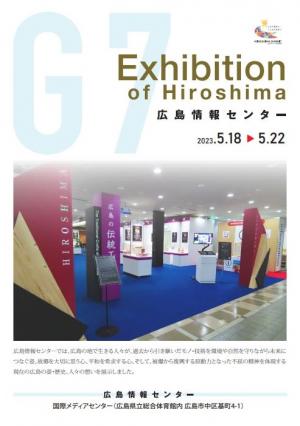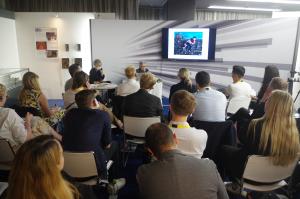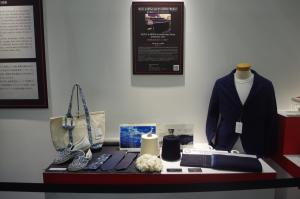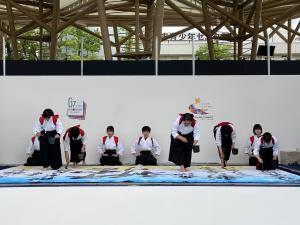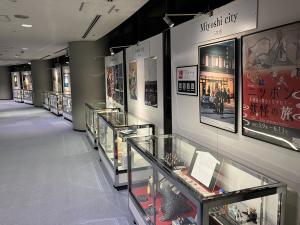Exhibition of Hiroshima
Home > Initiatives to Promote Attractive Features of Hiroshima > Exhibition of Hiroshima
Exhibition of Hiroshima
During the G7 Hiroshima Summit, the Exhibition of Hiroshima was held at the International Media Center (Hiroshima Prefectural Sports Center) to share attractive features of Hiroshima with members of the press who visited the prefecture from both inside and outside Japan, thereby, through them, disseminating information about Hiroshima to people around the world.
The exhibition highlighted the current status, history, and hopes of Hiroshima and its people, embodying their commitment to handing down heritages from their predecessors, including technologies, to future generations while preserving the natural environment, their love for their hometown, their desire for peace, and their unyielding spirit, which drove them to reconstruct their A-bomb-devastated hometown.
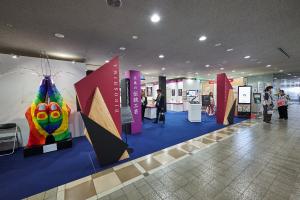
For more details, refer to this material.
Exhibition of Hiroshima (PDF)(3.14MB)
Exhibition themes
・Atomic Bombing/Reconstruction/Passing on the Torch
・The Traditional Crafts of Hiroshima
・The Food and Sake of Hiroshima
・The 23 Cities and Towns of Hiroshima Prefecture
Atomic Bombing/Reconstruction/Passing on the Torch
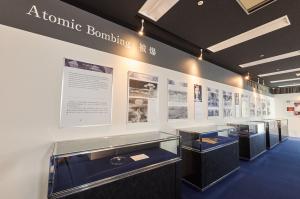
In August 1945, both Hiroshima and Nagasaki were completely devastated by atomic bombing, which indiscriminately claimed the lives of many innocent citizens. The two bombs also seriously impacted the lives of survivors.
Under the title “Atomic Bombing, Reconstruction, and Passing on the Torch,” the Peace Booth displayed actual materials from the Hiroshima Peace Memorial Museum collection to inform visitors of what really happened in Hiroshima on that day and in the aftermath, as well as other exhibits on the recovery of the city and local companies from the A-bomb attack and various current initiatives to hand down the experience of A-bomb survivors and to share the value of peace with people around the world.
In addition, to help the members of the press deepen their understanding of the real outcomes of the A-bomb attack, lectures were given by A-bomb survivors to provide as many visitors as possible with the opportunity to listen to those survivors in person.
For details about the exhibits, refer to the following.
The Traditional Crafts of Hiroshima
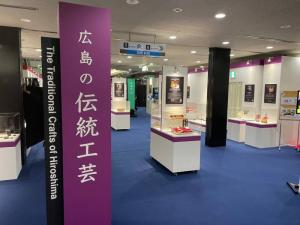
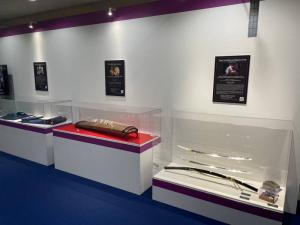
Hiroshima Prefecture’s traditional crafts are as varied as the regions that nurture them. In the south, the Prefecture faces the countless islands that dot the Seto Inland Sea. In the north, Hiroshima is enfolded in the mountains of the Chugoku Range, blessed by a mild climate that varies gracefully with the seasons.
In the midst of this bountiful natural beauty, numerous traditional crafts are raised, spread and passed down through generations. Crafted from natural materials by accomplished artisans, these traditional products convey the warmth and kindness of the people who made them.
Honed to perfection by generations of craftspeople, these crafts have evolved along with the uses to which they are put, yet the assured technique, attention to detail and patient craftsmanship of the artisans who make them are unaltered by the passage of time.
The Technology of Hiroshima
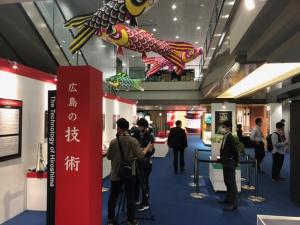
Industry in Hiroshima Prefecture is focused on monozukuri, manufacturing as a craft and art form. Manufacturing in this Prefecture consists of a deep, well-balanced mix, ranging from heavy industries such as shipbuilding, steelmaking and automaking to leading-edge industries such as production of electrical machinery and electronic components. For the past 11 years, Hiroshima Prefecture has topped the charts for the entire Chugoku/Shikoku/Kyushu region in terms of value of shipped manufactured goods.
The Prefecture’s manufacturing technology stands among the world’s best. In fields ranging from local industry to high-tech, the Prefecture’s companies include many that are one-of-a-kind, boasting unique, world-leading technologies, or that are No. 1 in national or global market share.
Heart of Hiroshima
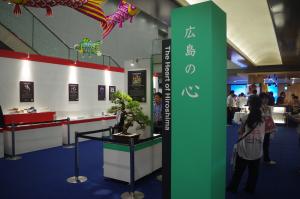
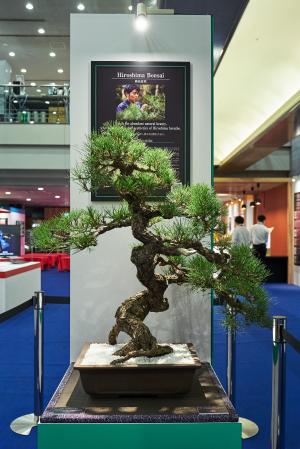
These exhibits feature a wide variety of works testifying to the unique spirit of hospitality of Hiroshima. Exhibits include beautiful and colorful koi carp, Hiroshima bonsai and withered bonsai inspired with new life as lacquered-leaf-covered wood. Other exhibits include mosaic art made by participants from within and outside Hiroshima Prefecture to welcome G7 Hiroshima Summit, children’s folded-crane art, a globe of roses made by students of Shudo Senior High School and a “flower wall” produced in Fukuyama City for the World Rose Convention.
About paper crane in Hiroshima(External website)
Environment of Hiroshima
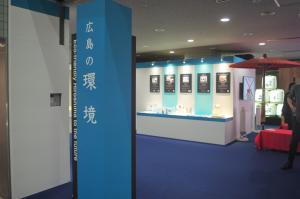
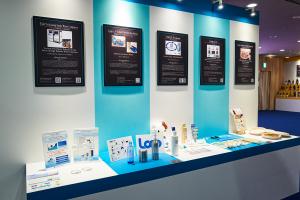
Hiroshima Prefecture is blessed with a beautiful and rich environment, beginning with our pride, the Seto Inland Sea, and the abundant green Chugoku mountain range.
In order to continue protecting this blessed and rich environment into the future, we aim to achieve a net zero carbon society with zero greenhouse emissions by 2050, by proactively centering carbon recycling-related technology and promoting the adoption of reusable energy. Furthermore, we aim to achieve zero new plastic waste outflow into the Seto Inland Sea by 2050, by popularizing the promotion of products made from alternative materials such as paper or reusable plastics, and plastic waste outflow preventative measures etc. Through these initiatives, in collaboration and cooperation with a variety of constituents, such as Hiroshima Prefecture’s citizens and business persons, we are working hard to comprehensively promote new environmental policies.
The Food and Sake of Hiroshim
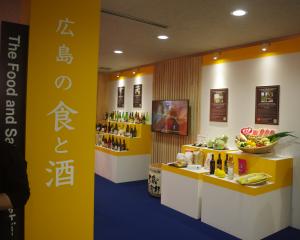
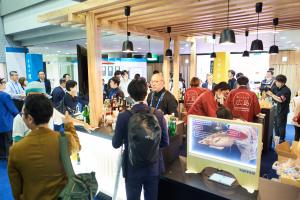
Blessed by nature’s abundance from the Seto Inland Sea in the south and the Chugoku Range in the north, Hiroshima Prefecture is replete with foods of excellent quality. With producers and consumers so close to each other, the Prefecture is brimming with shops and restaurants renowned for delicious cuisine prepared from a cornucopia of fresh ingredients.
Hiroshima Prefecture leads Japan in production volume for lemons, Oysters, Japanese beef with a long history, a wide variety of fish from the Seto Inland Sea, and of course the region’s soul food, okonomiyaki. From these delicious gifts of nature arose the region’s justly renowned food culture.
The Prefecture is also one of Japan’s “Big Three” saké brewing regions. Cornerstones of ginjo (top-quality) sake brewing were developed here, including the soft-water brewing method and motorized rice polishing. The 47 sake breweries scattered around the Prefecture produce a splendid variety of delicious sakes.
Experience corner
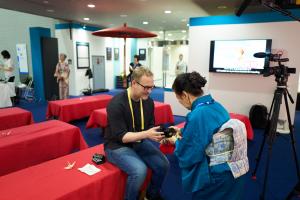
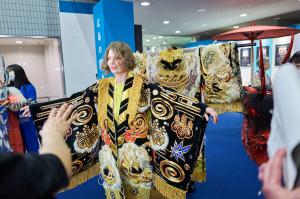
This interactive display area offers numerous experiences of the Hiroshima spirit of harmony. Here visitors can enjoy a tea ceremony by the Wafukai tea house of the Ueda Soko School, exhibits and try-on events for samurai armor and kagura robes, and projection mapping using saké barrels. Other exhibits include virtual-reality presentations on tourism and agriculture as well as “mini-experiences” on the environment.
Stage program
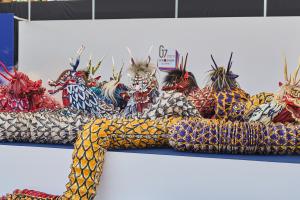
We present stage performances as only Hiroshima can, including Japanese drums, kagura (Shinto music and dance), ceremonial rice planting, Aki Hiroshima Busho-Tai and shodo (calligraphy) performances by students, as well as PR activities by cities and towns in Hiroshima Prefecture.
Hiroshima 23 Cities and Towns PR Corner
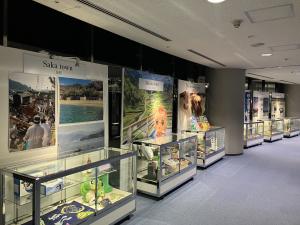
Hiroshima Prefecture is composed of 14 cities and 9 towns, for a total of 23 municipalities. Each city and town boasts its own unique sightseeing attractions, speciality products, history, culture, natural features and industries. There was a PR booth introducing each of the 23 cities and towns in the 1st floor hallway of the large arena.


